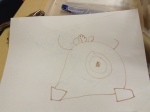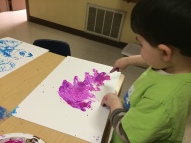Many times, I am asked by students who do practicum hours in my classroom (for those of you who do not know we are a lab school and I have students join the room who are freshman to seniors to experience life in a preschool room. Depending on the class, the students may observe, teach lesson or facilitate a project.) what is my favorite part about project work. I felt like this was perfect time to share with you my thoughts. Please feel free to add your own to the comments.
*The individual learning of each child!
-Some children may write a word for the first time.
-During this project, a little guy who is slow to warm has started the project work activity (whether it be my idea or his) every morning for three weeks (and counting!!)!
-Another of my little ones has remembered the origin of the ukulele and shares that with others.
-One of my older ones created his first three dimension representations and dealt with some frustrations along the way appropriately!
*The things that I learn as a teacher!!
– I learn about my own teaching such as how to engage children effectively with a project, what items I need to transform my room, and different ways to document the children’s learning.
-I also am able to see how amazing three, four and five-year olds are and always will be! I see them grow in their own learning, begin to learn to represent, set goals for themselves, and work together as a team.
-I learn details about specific items such as I now know all the parts of the ukulele!
*How caring our community (both classroom and beyond) are to our children!
-We had the opportunity to meet with a local weather man who was more than gracious to our classroom!
-Families have been an outpouring support whether in my classroom or the community in our building. This is also a wonderful way to get to know others and help teach the children about kindness, caring, and giving.
What’s your favorite part?






